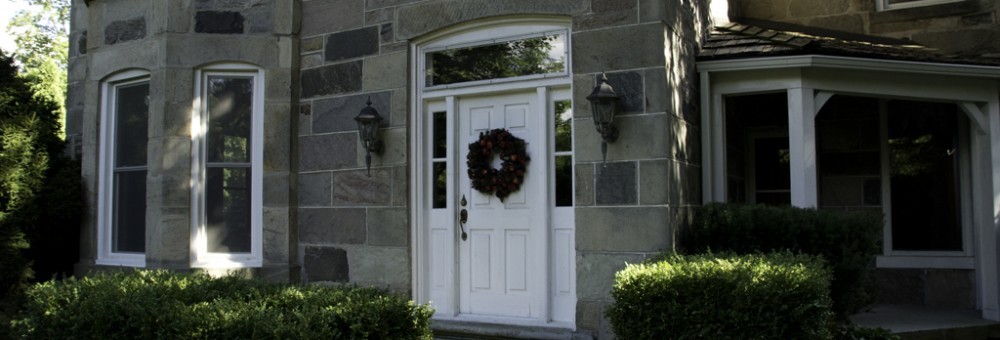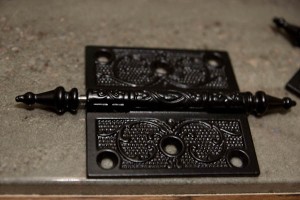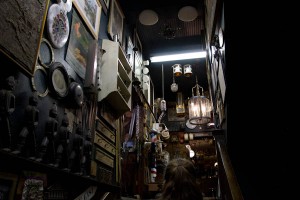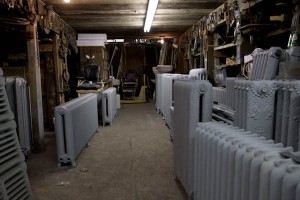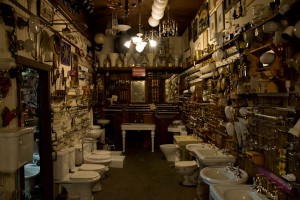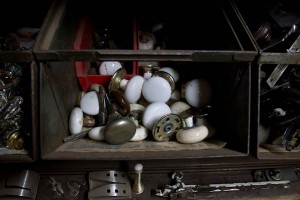One of the fundamental truths of renovating a very old house is that you never know what you are going to find. Normally, that means that you are going to discover things that you wish you hadn’t (and that will ultimately wind up being far more expensive than you wanted to know). In this case, however, gutting the bathroom resulted in a very pleasant surprise.
It turns out that all of the doors on the upper floor of the original house are original, and are hung on their original hinges. Said hinges have since been painted over many, many times now, of course, but they are – once numerous layers of paint are finally removed – absolutely beautiful. Keelan took the set from the bathroom door to see what he could do with them. After torching them, scrubbing them, brushing them and repainting them, they turned into something pretty spectacular.
Of course a discovery like this leads to the inevitable comment, “Wouldn’t it be cool if we could get more of these for the doors downstairs?” So, truth be told, even the positive surprises can wind up getting expensive. The question to be asked in all of this, however, is where one needs to go in order to find such hinges. Certainly they’re not something that you’re going to find in stock in your neighbourhood Home Depot.
There was some question even then about what kind of hinges they were, and whether or not they were in fact antique. The back of the hinges were stamped ‘3 1/2″ x 3 1/2″‘, which even today is a pretty standard size in the way of hinges. The offset pattern for the screws looks pretty similar to modern hinges. And one had to ask the question of whether, back in the late 1800s, they were as organized as all that as to be making standard size hinges, and then taking the time to make impressions in the back specifying just what size they were.
And so, we had a mystery on our hands. One I took it upon myself to attempt to solve as best that I could. Given that there were four doors in the downstairs of the old house (to the basement, to the front hallway, to Dianne’s den and to a new door on my den), the objective was to find four new sets of hinges to match the ones in the rest of the house. And really, how hard could that be?
The first stop in this particular odyssey was Addison’s. For anyone who has renovated anything in Toronto, they will know that Addison’s is the one-stop go-to place for reclaimed hardware of just about any size, shape and colour. It has also been profiled in just about every issue of Toronto Life’s annual “Where To Get Good Stuff Cheap,” for those who are slightly less tuned in. Just off of Sorauren in Toronto’s west end, Addison’s started off as a plumbing company run by Jim Addison, who started off in plumbing and heating in his native Scotland more than 50 years ago.
Today, Addison’s is still in the plumbing and heating business – with a three floor warehouse full to the brim of plumbing, electrical, hardware and heating products. They salvage what can be salvaged from houses that are being gutted, renovated or torn down, and sell the results to those who are gutting, renovating or tearing down their houses. If you have a hot water radiator that needs replacing, these are the people to see – they refurbish and restore old ones, as well as selling all the hardware necessary to keep them running.
Addison’s also has an absolutely ridiculous number of plumbing fixtures of every shape, size, purpose, colour and condition imaginable. It is truly spectacular, and organized mostly by category – so there is a reasonable chance of finding what you are looking for, located in proximity to all of the other examples of what you are looking for.
One of the things that they did have, to my surprise and absolute delight, was porcelain door knobs. Apart from replacing the hinges in the lower doors of the house, we are also wanting to replace the door knobs, which are an eclectic mix from several periods, none of which are actually from when the house was built. Briefly distracted, I was able to assemble three full sets of door knobs (at least, I was able to assemble the knobs, if not any of the other hardware I needed). Not knowing what was required in terms of latch sets (and recognizing the bewildering array of latches actually available) I wisely (in my opinion) left that decision for another day.
After a delightful exploration of a spectacular, if bewildering, array of stuff, we left with our knobs, but sadly not with our hinges. Stock depends upon what is coming out of houses that are being gutted, and most of the hinges they had were slightly worn and tarnished versions of what you would get from your local hardware store. The search would have to continue.
